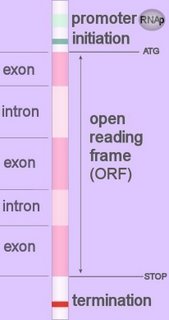 Exons are “the sequences of the primary RNA transcript (or the DNA that encodes them) that exit the nucleus as part of a messenger RNA molecule. In the primary transcript neighbouring exons are separated by introns.” Find exons : Find introns : Find gene :
Exons are “the sequences of the primary RNA transcript (or the DNA that encodes them) that exit the nucleus as part of a messenger RNA molecule. In the primary transcript neighbouring exons are separated by introns.” Find exons : Find introns : Find gene :In other words, exons are those sections of DNA within a gene that are not spliced out from the transcribed precursor mRNA and that are retained in the final messenger RNA (mRNA) molecule. For many genes, each exon contains part of the open reading frame (ORF) that codes for a specific portion of the complete protein. However, the term exon is often misused to refer only to coding sequences for the final protein. This is inaccurate since many noncoding exons are known in human genes (Entrez).
Exonic regions differ statistically from intronic sequences in terms of base composition and hexamer frequency (19,20). Pseudoexons are located within intronic regions
The term "exon" was coined by Walter Gilbert in 1978. Gilbert shared the 1980 Nobel Prize in Chemistry with Paul Berg and Frederick Sanger.
The Exon-Intron Database
No comments:
Post a Comment
Note: Only a member of this blog may post a comment.